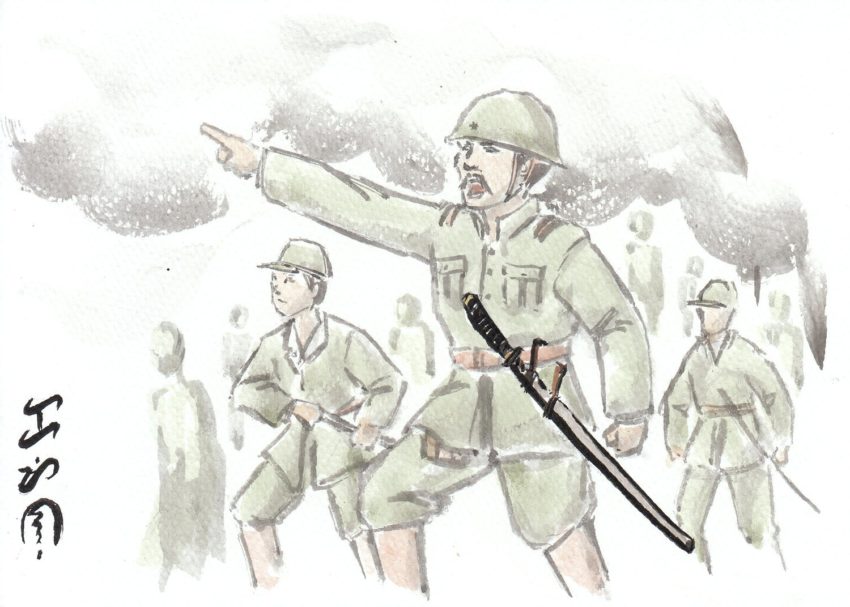Japanese swords are among the most captivating aspects of the nation’s military culture. Unlike artillery, tanks, or explosives, swords possess a unique kind of quiet power. It is no wonder that a WW2 Japanese sword is eagerly sought after by many buyers and collectors. But, despite their beauty and popularity with collectors, the use of these swords is a dying art.
Swords were used regularly by warriors for many centuries prior to the Meiji Era of 1868-1912, but these antique Japanese swords swiftly became rarities as the samurai class progressively disappeared. That quick turnaround was soon followed by an opposing one: the Showa Era (1926-1989) saw a resurgence in the production and collection of swords.
WW2 Japanese Sword Production in Showa
The Showa period encompassed all of World War II. The swords made during World War II differed from samurai-era weaponry in different ways. For example, a samurai-era katanaKATANA 刀 "sword" learn more... would preferably be made with aged steel, which had a high concentration of oxygen and was easier to stretch. It was also easier to clean impurities out of old steel. The steel would be folded several times before the blade itself was fashioned. That blade would be carefully cooled, forged, and finally polished. Even the latter stages of a sword’s creation were undertaken with great care: Polishing was a sophisticated process that could easily claim a week’s worth of time.
However, a WW2 Japanese sword would not undergo such a sophisticated process. During the preparations for the war, all Japanese officers were required to wear a sword as part of their uniforms. The incredible demand to outfit so many people meant that each Japanese officer sword had to be produced quickly and efficiently. Time could not be spared for traditional craftsmanship. Although traditional Japanese weaponry was still being made by the most-skilled swordsmiths, more inexperienced swordmakers were commissioned to make the swords for officers.
Since traditional swordmaking during this time was no longer a widely-practiced art, supplies for traditional swords were few and far between. Different types of steel had to be used in order to produce a WW2 Japanese sword. Varied tools were used to make swords. Sometimes, the tools would be unable to yield the lovely details of traditional swords. Most significant of all, perhaps, blades were not cooled and tempered using traditional methods. The blades of WW2 are called showatoSHOWATO 昭和刀 "Showa-era sword" learn more..., or Showa-era swords. These weapons are not typically regarded as collectible artifacts by the Japanese themselves, but fortunately for foreign enthusiasts they are still collected and cared for elsewhere as historical objects.
Kunitoshi, WW2-era Sword Maker
One example of a swordsmith during this time is a maker named Kunitoshi. He came from a family that traditionally produced warships, cannons, and other artillery. He apprenticed himself to an older sword maker named Yoshinobu, and during the World War II era he was trained by a team of other highly experienced sword makers. Kunitoshi was eventually contracted by the Army to make swords during the war. He exhibited a talent in many of the older pre-war traditions.
Keeping Older Traditions Alive Anyway
Some effort during the war was in fact made in order to protect the traditional nature of Japanese sword making, so older-style refined blades were produced in small batches and purchased by distinguished military officers. And although there is a strong impression amongst the Japanese that showato blades are inferior products due to their mass production, they are actually quite excellent in quality. It’s quite possible to find a WW2 Japanese sword comparable in quality to swords made before the Meiji Era.
The Role of the WW2 Japanese Sword
Japanese swords conferred high status on the officers who wore them. However, they did not become something heavily used during the wartime period. Though elegant in appearance, they could of course not hope to compete with modern-day artillery and weaponry. Firearms and grenades could do far more damage than a sword could accomplish. Japanese officers occasionally used their swords, but they played a secondary role to the modern weapons they integrated into their military culture. Other countries would also use their traditional weapons during the war, but they became secondary to the modern weapons that dominated the military.
Though they did not stand up to newly developed weapons in terms of function, Japanese showato swords played a crucial role for the soldiers. They evoked the sentiments of a past era and helped officers remain connected to their cultural heritage. Although the samurai warrior class was no longer a part of modern-day warfare, showato swords inspired World War II soldiers to feel obligated to emulate samurai ideals. In this way, the new sword, mass-produced thought it may have been, imparted stoicism, deep respect for superiors, total fearlessness in battle, profound loyalty, and honorable conduct to Japanese soldiers.
WW2 Swords and Symbolism
When swords were used, they were sometimes used in ways that felt symbolic. For example, as Japan gradually occupied Malaya during the 1940s they used propaganda to win over Malay loyalty. The British military was portrayed as an exploitative force that wished to take Malayan resources for itself. The Japanese tried to pose as the saviors of the Malayan people. However, the World War ended and the Japanese had to surrender according to the terms laid out in the Potsdam Declaration, and swords became a significant part of the optics of this historical moment.
The Declaration called for the surrender of all Japanese armed forces and demanded the elimination of Japanese authorities who wanted world conquest. Certain parts of Japanese territories would be subject to occupation by the Allies. Japanese military forces would be entirely disarmed and allowed to go back to their homes with the expectation that they would lead quiet lives. The Japanese government was expected to declare unconditional surrender and offer assurances that they would comply with everything outlined in the Declaration. No alternative was offered other than “prompt and utter destruction”. In response, Japan surrendered and followed the terms specified in the Declaration.
Laying Down Their Swords
As part of the surrender, Japanese forces occupying Malaya also surrendered. As an act of compliance, Japanese soldiers yielded their showato swords to Indian troops in the Malayan area. They removed the blades from their uniforms and placed them on the ground for later removal. (The same was also done to all their firearms.) The swords of the military were no more; the war was over and the showato blades were sacrificed for peace.
Japanese Swords After WW2
After the end of the war, weapons production was halted in Japan and the era of the WW2 Japanese sword was dead. Japanese weapons and swords were confiscated. This took place for a year until the cultural value of the swords was recognized. After this, swords were no longer to be taken out of the country. Even so, many Westerners took home Japanese swords to keep as souvenirs. For a while, more Japanese swords may have been located in the West than in Japan. This may have lasted until sword-making started to be practiced again during the late 1900s.
The swords are valued today as a remnant of a past when they played a crucial role in a Japanese soldier’s life. Today, these swords are beloved as art objects and historical artifacts. They are never used for military purposes, though they are occasionally used for traditional martial arts.
Japanese sword-makers today follow traditional methods and use traditional materials for sword production, although cheaper imitations are also made. (These often rival “authentic” swords in beauty and style.) Japanese swords are often exhibited in museums. The Japanese Sword Museum in Tokyo, for example, has collected swords as historical artifacts since 1948. They too are regarded as works of art.
WW2 Japanese swords are also frequently collected by universities and individual collectors who view them as part of history. These weapons are not as highly thought of in Japan, but Western collectors continue to value them for their quality, their workmanship, and their role in World War II Japanese uniforms and daily life. The swords are often exhibited in a way that shows off the gentle curvature of the billet and the fine detail of the craftsmanship – reminding us all of the graceful nobility of WW2-era swords from Japan.

